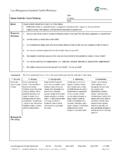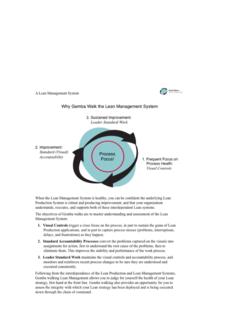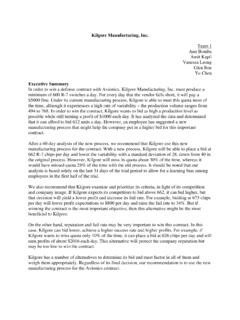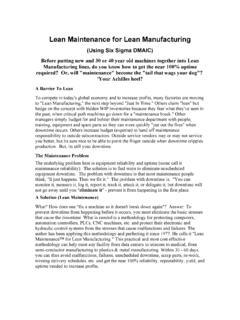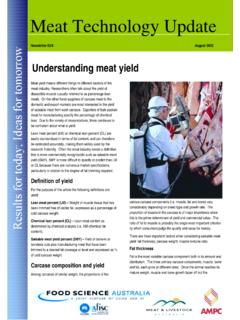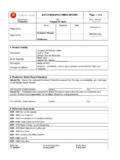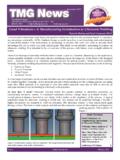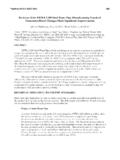Transcription of Lean Management Standards: Manufacturing
1 lean Management standards : Manufacturing 2014 DMLC Reprinted by Permission Few<25% Some<50% Most>75% All=100% From Creating a lean Culture, 3rd Edition Leader Standard Work Date: Location: Diagnostic Questions: 1. Do leaders have standard work? Do they follow it? Do you carry it with you as a routine? Do you have it with you now? 2. Is leader standard work regularly reviewed for updating? Has it been updated recently; when was last time? 3. Are standard work documents used as working documents, as a diary of the day? Are the leader standard work documents reviewed daily by leaders' supervisors? Weekly with the subordinate? 4. Is there a regular place where completed standard work documents are stored? Is it visual? Is a leader standard work form available for all to see? 5. Has leader standard work been used in this area in transitions between leaders?
2 Progress Notes 1 No leader standard work is in evidence. Some leaders have heard of the idea of leaders standard work. Most leaders see standard work as applicable to production jobs only. 2 Leader standard work exists for a few isolated positions. Where it exists, leader standard work is carried out some of the time and filled out irregularly. Leader standard work has not been revised. Most leaders talk about it as a compliance, check the box exercise. 3 Standard work is in place for all leaders in the value stream, team leads through value stream manager. The standard work for all leaders has been revised once. Most leaders carry their standard work with them, follow it, and use it as a working daily document. Most leaders understand the benefits of standard work and can give examples of how it has helped them.
3 4 All leaders carry and follow leader standard work and use it as a working daily record. All superiors regularly review subordinates' standard work documents daily All leaders can identify how standard work benefits them. Standard work is regularly reviewed and revised. 5 Standard work is regularly reviewed daily by the next level as a monitoring and communication vehicle. It is reviewed weekly jointly by subordinate and supervisor for patterns, revisions. Completed standard work documents are visually maintained by day of week for each leader. A blank copy of leader standard work is posted in the area. All transitions between leaders include review and walkthrough of leaders standard work. All new leaders follow standard work from day one on the job. Pre-Implementation Beginning Implementation First Recognition State System Stabilizing Sustainable System lean Management standards : Manufacturing 2014 DMLC Reprinted by Permission Few<25% Some<50% Most>75% All=100% From Creating a lean Culture, 3rd Edition Value Stream Maps Date: Location: Diagnostic Questions: 1.
4 Are there documented plans for improvement visible in each area - at least each department? 2. Are current process improvement activities visible in each area? 3. Are value stream maps used to identify and track process improvements? 4. Are value stream maps available for current and future state? 5. Do future state maps show planned kaizens, completion status of kaizens, and specific targets for improvement in measures of process performance? 6. Who prepares value stream maps for the area? How many of the area's leaders are proficient value stream mappers? Progress Notes 1 Value stream maps are not in use, or were used once but are out of date. They are not part of the area s approach to improvement. Few people, if any in the area are proficient at value stream mapping. 2 Value stream maps can be seen posted in the area, may once have been used as an improvement-planning tool, but they are out of date.
5 Some technical specialists (engineers, lean leads) know how to map value streams. Most line Manufacturing leaders do not. Value stream maps, when present, show the current state only. Or, if future state maps are present, they are out of date. 3 Most areas have visible plans for improvement; many of these shown as current and future state value stream maps with kaizen bursts showing planned improvement and reflected on A3s. Some of the future state maps show planned improvement in specific value stream process measures (such as lead time, % VA time, yield, productivity, uptime, changeover times). In areas with current value stream maps, supervisors and superintendents are proficient value stream mappers and draw their own maps. 4 All value streams display current state and 90-day future state maps showing improvement goals (measures) and activities (kaizens).
6 All supervisors in the value stream are proficient value stream mappers, draw their own maps, and use mapping to systematically understand opportunities large and small. Completion status of kaizens is shown on the value stream maps, linked to A3 boards, and reflected in status of progress against 90-day goals. 5 Value stream maps are regularly used in the area s communications. Front line leaders teach value stream mapping. All team leaders are proficient value stream mappers. All departments and teams use posted value stream maps to show their improvement plans. Each area s performance (down to the team) is reflected in the current state measures summary on its value stream map ( lead time, % VA time, yield, productivity, uptime, changeover time). Pre-Implementation Beginning Implementation First Recognition State System Stabilizing Sustainable System lean Management standards : Manufacturing 2014 DMLC Reprinted by Permission Few<25% Some<50% Most>75% All=100% From Creating a lean Culture, 3rd Edition Visual Controls Production Date: Location: Diagnostic Questions: 1.
7 Are visual controls in evidence for production processes in flow and pull areas? Are they current? 2. Are reasons for misses or flow interrupters described clearly and specifically enough to decide what next steps to take? 3. Are visuals regularly reviewed and used to drive improvement? How? Are improvements stimulated by visuals limited to crisis situations, or are there many, often small, improvements driven by visuals? 4. Are visuals in regular use for out-cycle tasks like waterspider routes, operator-based maintenance tasks, 5. Are visuals revised and changed as conditions change and issues either emerge or are resolved? Example? 6. Are visuals regularly signed off / initialed by leaders in the area? 7. Are visuals self-documented with "who does what here when" information at or on the visual controls themselves?
8 Progress Notes 1 There are no visual controls in evidence 2 Production tracking charts are posted in flow area only. Production tracking charts complete for few days or intervals of observation. They are often filled in irregularly with a focus on production numbers only. Reasons for misses are absent or too vague for action There is no or only irregular daily review of production visuals; response to information on the visuals is either absent or irregular. Visuals are a check the box activity. 3 Production tracking charts in flow areas are filled out regularly. Most reasons for misses are specific and actionable. Visuals are reviewed daily, and most of the time drive specific action assignments on an identified major interrupter or problem. 4 All reasons for misses are clear and actionable. Visuals are reviewed daily, and regularly lead to specific action assignments on small as well as large flow interrupters and other problems.
9 Tracking charts are in use at pacemaker, in flow and in pull areas. Visuals are added and discontinued as needs change. 5 Visuals are in regular use for out-cycle tasks throughout the value stream. All production charts are initialed several times daily by department and value stream leaders, and occasionally by plant managers and executives. Visuals are regularly analyzed to identify most frequent interrupters or problems, which then drive problem solving and improvement implementation. Pre-Implementation Beginning Implementation First Recognition State System Stabilizing Sustainable System lean Management standards : Manufacturing 2014 DMLC Reprinted by Permission Few<25% Some<50% Most>75% All=100% From Creating a lean Culture, 3rd Edition Visual Controls Production Support Date: Location: Diagnostic Questions: 1.
10 Are visuals in evidence for non-production processes such as labor planning, 5S, Are they current? 2. Can leaders explain how actual versus expected performance can be visually controlled in non-production tasks? 3. Is review of non-production visuals included in the appropriate leaders' standard work? 4. Are improvements stimulated by visuals limited to crises or are there many improvements, small as well as large? 5. Are visuals regularly reviewed and used to drive improvement? How? Example? 6. What visuals are used to display and monitor TPM schedule and performance, SPC charts, daily calibration, quality checks, Progress Notes 1 No visuals exist. Monitoring and reports of production support activities, if any, are on IT systems, in rarely referred to books, or in local, informal, undocumented systems. 2 Some leaders understand it is possible and the reasons for applying expected-versus-actual visual tracking for non-production processes.

